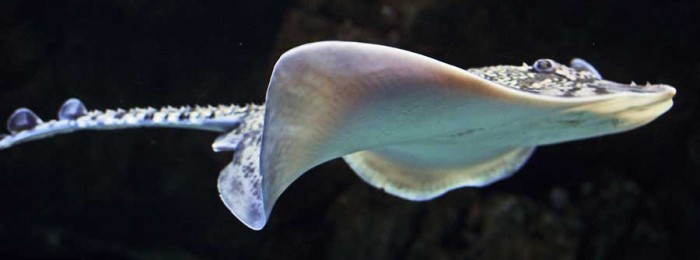01843 585310
info@kentandessex-ifca.gov.uk

01843 585310
info@kentandessex-ifca.gov.uk

Date updated: February 2014
Fishery location: Across the district
Fishing Gear: Recreational Sea Angling, nets, trawls
Season: all year
Primary Management Tool: Kent and Essex IFCA byelaws for minimum landing size
Lead Regulator: Kent and Essex IFCA
Quota: Quota species set by MMO regionally.
Important fish for recreational sea and shore-angling and one of the most important commercial fish for local and North Sea fishermen. Thornbacks are one of the four main finfish targeted commercially in the region, and since the reduction in cod, it has become even more important to the fishing fleet
Thornback rays are predominantly feeders of small bottom dwelling crustaceans when juveniles but extend their diet as they grow larger to include larger crustaceans such as swimming crabs, sandeels and small gadoid species. Thornback eggs form an important food source for some fish, while juveniles are preyed upon by larger fish species and adult thornbacks.
Thornback ray is found across most of the KEIFCA district with fish being present throughout from early spring to late autumn traditionally. However, in recent years it has been noted that thornback rays have been seen further up rivers during the summer months and present in some parts of the district year round.
Thornback ray has the same general shape as other rays being disc shaped with broad pectoral fins joining the head and body. The tail is long and narrow, approximately the same length as the body. The upper surface of thornback rays have a number of thrones which increase in size and number as the animal ages. Females typically grow larger than males with maximum lengths of 118 cm and 98 cm respectively. Thornback rays are oviparous and lay eggs inshore between March and September. Females reach sexual maturity later than males at 8.8 and 7.1 year respectively and will produce between 140-160 eggs in a year in sandy or muddy substrate inshore. Usually found in coastal waters ranging from 10 - 60 m on mixed sea bed types including mud, sand, shingle, gravel and rocky substrates they are known to range into deeper waters. Thornbacks are thought to migrate offshore during winter months and inshore for the summer reproductive season. However number of thornbacks remaining in inshore waters seems to be extending further into the winter months in recent years in the Thames estuary area, with some thought to be resident all year round.
At present there is no information available on CPUE and Stock in the district. Landings data for thornback rays landed into ports in Kent and Essex is available although this is not limited to fish caught inside the district boundary.
Kent & Essex IFCA are pleased to be part of the European project INTERREG 2 Seas SUMARiS (Sustainable Management of Rays and Skates).
The SUMARiS project aims to put together the necessary knowledge and evidence in order to implement a species specific cross-border management strategy for rays and skates fishery in the English Channel and the North Sea, in particular by setting up common and cross-border management.
A large majority of fishermen operating in these areas have artisanal fishery vessels (8 to 25 m.), targeting a large composition of species, most of which are managed with a European Total Admissible Catch (TAC). The TAC for rays and skates pools together several species of different conservation and exploitation status, which is poorly supported by fisheries and scientific evidence. SUMARiS will impact the management of rays, to make it more species-specific, economically-efficient and socially acceptable for the fishing industry while protecting the less-known species. Rays will also be subject to Landing Obligation (LO) requirements from 2019 onwards. The project will anticipate the rays' LO, by encouraging fishermen to adapt their fishing strategies, so to avoid discards and/or release rays alive at sea.
By gathering the existing data and completing it, the fisheries' professional and scientific partners from the three participating countries will be able to adopt an evidence-based joint management strategy, protecting less-known species and allowing economic balance for sustainable fishery activities. This up-to-date knowledge about the rays and skates stocks will allow all partners to monitor the exploited zones in an appropriate way. The survivability exemption and the ability to handle correctly rays on board will allow fishermen to release rays alive back at sea.
The project is being conducted by different member states (the UK, Netherlands, Belgium and France) in partnership with producer organisations (FROM Nord, Rederscentrale), scientific organisations (Institut Français de Recherche pour l'Exploitation de la Mer - IFREMER and Instituut voor Landbouw- en Visserijonderzoek - ILVO), Nausicaa, the French National Sea Centre and associated partners (VisNed, the AQUIMER Hub and CEFAS).
© Kent & Essex IFCA 2026 - All Rights Reserved | Privacy Policy